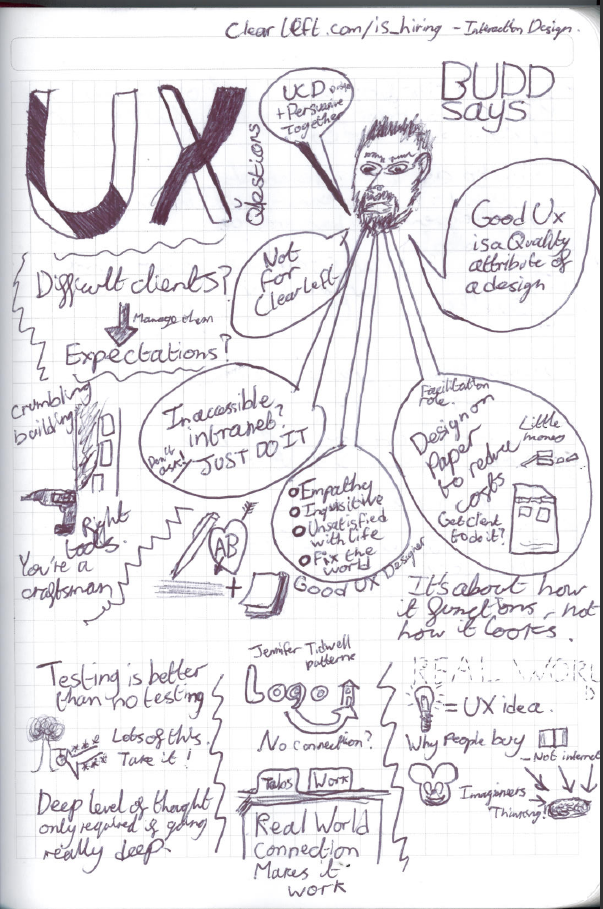UX Questions with Andy Budd
Posted on by Steve Workman About 3 min reading time
Last night was London Web Standards' UX Questions with Andy Budd (of CSS Mastery and Clearleft fame)
My sketchnotes for this are at the bottom of the page. This is only a brief write-up, hopefully the LWS guys will put the video up soon. Much of this is para-phrased. Andy, if you do read this, let me know if you want any of these answers changed.
Q: Good UX vs Good design? (the actual question was a lot more wordy than that)
UX is a quality attribute, it can be good and bad. An aspect of good design takes UX into account, though there are exceptions i.e. the Phillips Juicer. Good design does not imply ease of use, UX is a design philosophy or style. A good UI designer understands HCI, social, environmental and cognitive psychology .
Q: User-Centric Design or Persuasive Design?
Both together please.
Q: How do you manage difficult clients?
Clearleft tend not to get them thanks to their reputation. Basically, just manage expectations all the way through.
Q: What should you do if you're told to design "for IE 6" or "inaccessibly"
Ignore the request. You're a professional (dammit) and you need to use the right tools for the job. Don't just keep patching a crumbling building, i.e. if you have an intranet made for IE6, don't just patch it up, start again.
Q: What tools couldn't you live without?
Pen and paper. Oh, and sticky notes.
Q: What makes a good UX designer?
- Empathy
- Inquisitive
- Unsatisfied with life (want to make things better)
- Desire to fix the world
Q: How do you get clients to invest in UX even if they have a small budget?
Design on paper to reduce costs. Too many designers just go straight into photoshop. This will allow for more iterations and less money in the long term. Remember that you're also in a facilitation role so its up to you to guide the process.
Q: Is any testing better than no testing?
Yes.
Generally there's lots of low-hanging fruit (if doing a re-design) so take that! You only need to do the deep level of thought if you're solving a very specific problem.
Q: Are there any design patterns you use regularly? Should you make new ones?
Real-world patterns work very well, i.e. tabs. Most people don't know that a site logo takes you to the home page, so always have a home link. If you're making a new pattern, test test test, then think, would something else be better.
Q: Where do you get your inspiration from?
The real world. Architecture, a book called "Why people buy" (but not the section on the internet), the Disney Imagineers. Overall, it's about how it functions, not how it looks.
Q: Is the user wrong? When does the designer know better?
Generally, the user isn't wrong. It's very rare that their opinion doesn't count, so swallow your pride.
Q: How do you establish credibility in an organisation?
It's difficult, very hard to do internally. You need to play the office politics game. Build a level of knowledge and use references as much as you can, so it's not only you saying these things. Have confidence in you and what you are doing. Visualise it in your client's language if possible.
Q: What should you do if a business objective creates a disjointed experience?
Andy can't help on this one, this is an answer from the LWS crowd.
Switch it around, get buy-in from people and sell ti to them. Do it in the pub, many people are much more open there. With regard to "Dark Patterns" i.e. hiding a company's phone number or directing through certain channels, read Dan Lockton's post.
Finally, if you're not happy in your job, there are loads of UX jobs out there at the moment. Clearleft is hiring a world-class interaction designer.
That's it. Sketchnotes below. Hope you enjoyed it
